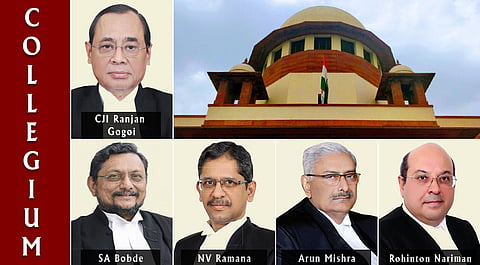
- Latest Legal News
- News
- Dealstreet
- Viewpoint
- Columns
- Interviews
- Law School
- Legal Jobs
- हिंदी
- ಕನ್ನಡ

In a departure from the practice that has been followed over the last two years, the Supreme Court Collegium has not given the details surrounding its recommendations for judicial appointments.
The latest resolutions published on the Supreme Court website merely state the Collegium’s decision “after taking into consideration the material on record”. For example, the decision to recommend a judicial officer for elevation as a judge of the Meghalaya High Court now simply reads,
“The Supreme Court Collegium in its meeting held on 15th October, 2019, after taking into consideration the material on record, has approved the proposal for elevation of Shri Wanlura Diengdoh, Judicial Officer, as Judge of the Meghalaya High Court.”
A similar pattern is seen in the rest of the resolutions published pursuant to the Collegium’s October 15 meeting.
Earlier resolutions detailed the way appointment recommendations moved from the High Court Collegium to the five seniormost judges of the Supreme Court. The views of the Centre and the information provided by the Intelligence Bureau were also referred to in some resolutions.
The Supreme Court Collegium had first taken the decision to make its resolutions public in October 2017, when Justice Dipak Misra was Chief Justice of India. A statement issued back then read:
“THAT the decisions henceforth taken by the Collegium indicating the reasons shall be put on the website of the Supreme Court, when the recommendation(s) is/are sent to the Government of India, with regard to the cases relating to initial elevation to the High Court Bench, confirmation as permanent Judge(s) of the High Court, elevation to the post of Chief Justice of High Court, transfer of High Court Chief Justices / Judges and elevation to the Supreme Court, because on each occasion the material which is considered by the Collegium is different.
The Resolution is passed to ensure transparency and yet maintain confidentiality in the Collegium system.”
Though the move was welcomed by a large portion of the legal fraternity, there were some who raised concerns regarding the practice. Justices Madan Lokur and Kurian Joseph – who were part of Misra J’s Collegium – expressed their reservations against the move.
Senior Advocate Harish Salve had also pointed out to Bar & Bench,
“If the names of those considered and rejected are made public, it will be an unmitigated disaster. The appointments to the High Court are from the subordinate courts. A rejection would result in criticism of the judge being made public. He would have to resign. Worse – those high court judges who are not elevated to Supreme Court. A litigant will be entitled to demand that his case not be heard by a judge found unfit for elevation.
Secondly, the reasons for rejection would never bear scrutiny. They will undoubtedly be challenged – cannot fathom the consequences.”
The change comes in the wake of criticism levelled against the Collegium following its decisions regarding former Madras High Court Chief Justice VK Tahilramani and Justice Akil Kureshi, whose appointment as Chief Justice of the Tripura High Court is yet to be notified.
Last month, the Supreme Court Secretary-General issued a statement that the Supreme Court no hesitation in disclosing reasons for transfer of judges if found necessary.